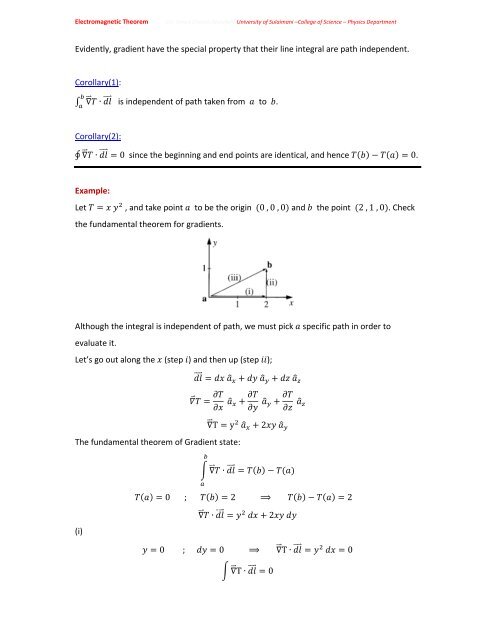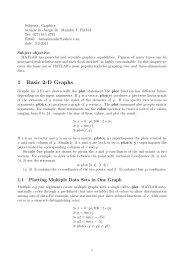Chapter One: Vector Analysis The use of vectors and vector analysis ...
Chapter One: Vector Analysis The use of vectors and vector analysis ...
Chapter One: Vector Analysis The use of vectors and vector analysis ...
Create successful ePaper yourself
Turn your PDF publications into a flip-book with our unique Google optimized e-Paper software.
Electromagnetic <strong>The</strong>orem<br />
(Dr. Omed Ghareb Abdullah) University <strong>of</strong> Sulaimani –College <strong>of</strong> Science – Physics Department<br />
Evidently, gradient have the special property<br />
that their line integral are path independent.<br />
Corollary(1):<br />
<br />
<br />
∙ is independent <strong>of</strong> path taken from to .<br />
Corollary(2):<br />
∮ ∙ <br />
0 since the beginning <strong>and</strong> end points are identical, <strong>and</strong> hence 0.<br />
Example:<br />
Let <br />
, <strong>and</strong> take point to be the origin 0 , 0 , 0 <strong>and</strong> the<br />
point 2 , 1 , 0. Check<br />
the fundamental theorem for gradients.<br />
Althoughh the integral is independent <strong>of</strong> path, we must pick specific path in order to<br />
evaluate it.<br />
Let’s go out along the<br />
(step ) <strong>and</strong> then up (step );<br />
<strong>The</strong> fundamental theorem <strong>of</strong> Gradient state:<br />
<br />
0 ;<br />
<br />
<br />
<br />
T y 2 <br />
<br />
∙ <br />
<br />
2<br />
<br />
<br />
<br />
⟹<br />
<br />
<br />
2<br />
(i)<br />
∙ 2<br />
<br />
0 ;<br />
0<br />
⟹<br />
T<br />
∙ 0<br />
T<br />
∙ 0
















